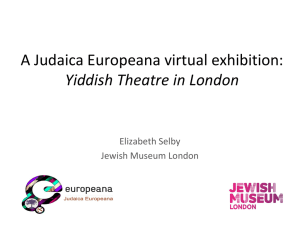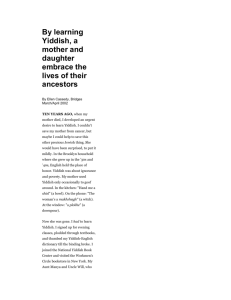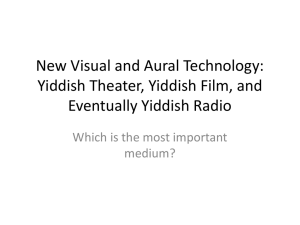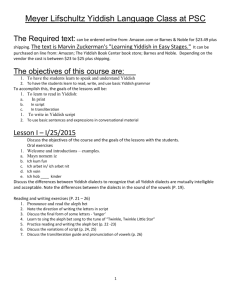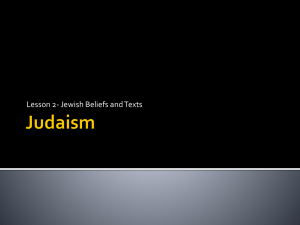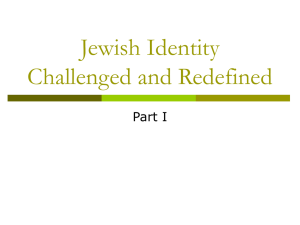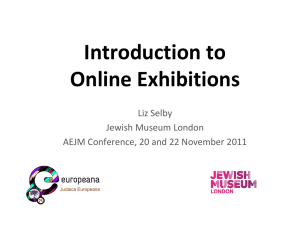Pieces of Culture
advertisement
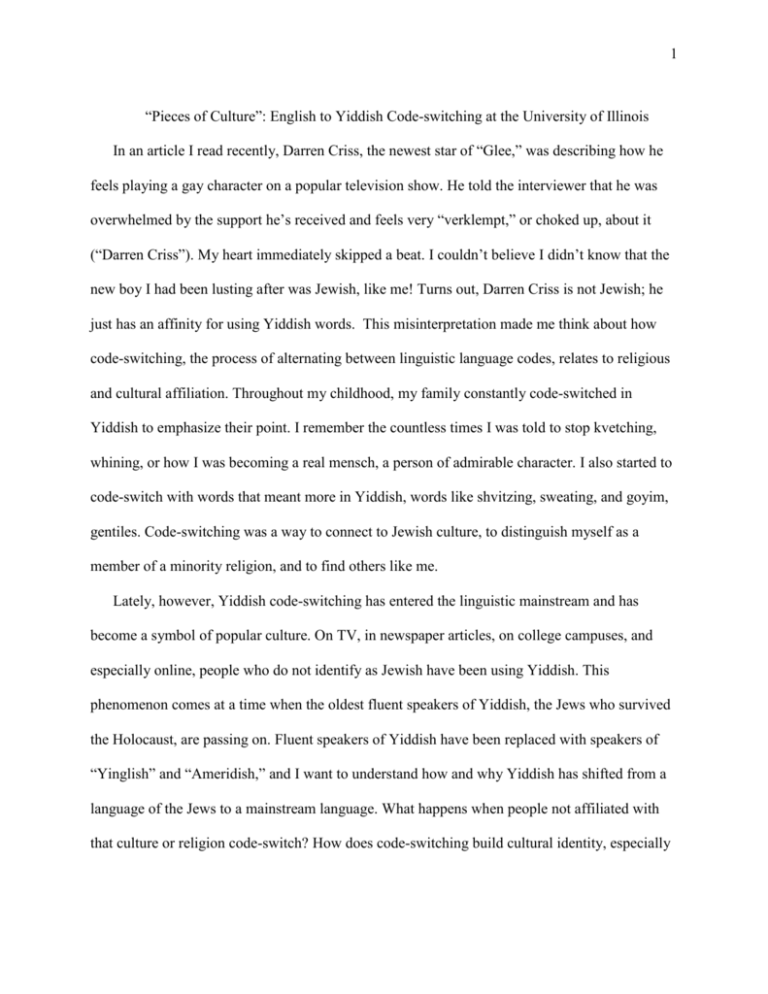
1 “Pieces of Culture”: English to Yiddish Code-switching at the University of Illinois In an article I read recently, Darren Criss, the newest star of “Glee,” was describing how he feels playing a gay character on a popular television show. He told the interviewer that he was overwhelmed by the support he’s received and feels very “verklempt,” or choked up, about it (“Darren Criss”). My heart immediately skipped a beat. I couldn’t believe I didn’t know that the new boy I had been lusting after was Jewish, like me! Turns out, Darren Criss is not Jewish; he just has an affinity for using Yiddish words. This misinterpretation made me think about how code-switching, the process of alternating between linguistic language codes, relates to religious and cultural affiliation. Throughout my childhood, my family constantly code-switched in Yiddish to emphasize their point. I remember the countless times I was told to stop kvetching, whining, or how I was becoming a real mensch, a person of admirable character. I also started to code-switch with words that meant more in Yiddish, words like shvitzing, sweating, and goyim, gentiles. Code-switching was a way to connect to Jewish culture, to distinguish myself as a member of a minority religion, and to find others like me. Lately, however, Yiddish code-switching has entered the linguistic mainstream and has become a symbol of popular culture. On TV, in newspaper articles, on college campuses, and especially online, people who do not identify as Jewish have been using Yiddish. This phenomenon comes at a time when the oldest fluent speakers of Yiddish, the Jews who survived the Holocaust, are passing on. Fluent speakers of Yiddish have been replaced with speakers of “Yinglish” and “Ameridish,” and I want to understand how and why Yiddish has shifted from a language of the Jews to a mainstream language. What happens when people not affiliated with that culture or religion code-switch? How does code-switching build cultural identity, especially 2 on a culturally diverse campus like the University of Illinois? With the constant shifting of national cultures in today’s society, what happens when culture becomes secularized? While many linguistic researchers have written about the act of code-switching, none have specifically written about English to Yiddish code-switching. Yiddish is a cultural language, the germanic language of Jews from Eastern and Central Europe, the Ashkenazi Jews, and is a fusion of German dialects as well as Hebrew, Aramaic, Slavic languages, and traces of Romance languages. Historically, Yiddish was a secular language, used outside of the synagogue while Hebrew was traditionally used for religious study. However, in recent generations Hebrew has expanded to become the official language of the Jewish state of Israel and has arguably contributed to the downfall of Yiddish. According to scholar Amelia Glaser, “For a combination of reasons that cannot be separated from the Holocaust, the rise of Modern Hebrew, or assimilation, Yiddish has transformed from the lingua franca of European Jews to a language spoken by...insular communites of the so-called ultra-Orthodox” (151). Today, Yiddish is a dying langauge, although there have been efforts to recover it. According to a recent New York Times article, hundreds of people get together in the Catskills every year to study Yiddish, even people who aren’t Jewish (Berger C38). Code-switching in Yiddish has become a cultural symbol rather than a linguistic necessity. Michelle Hall Kells reiterates this point in her article about Tejano code-switching when she says, “Codeswitching as a speech act has linguistic...as well as symbolic (metaphorical) value” (28). Perhaps code-switching in Yiddish is a way to preserve a dying langauge, or it can be used metaphorically to hearken back to a simpler time in America, when people mixed languages to show their cultural affiliation. However, is secularizing a cultural language something to take pride in? When does secularization cross the line from promoting culture to destroying it? 3 To understand how University of Illinois students feel about Yiddish to English codeswitching, I interviewed Keren, a senior who is actively involved in the Hillel Foundation and considers herself to be Jewish. On a bright Saturday morning, I entered Keren’s apartment for our interview. She was sitting at the table, working on homework. Her apartment was heavily decorated; paintings and posters adorned the walls. She welcomed me in with a smile and beckoned me to sit down next to her. Keren was born to Jewish parents and mentioned that she tends to jump around between the three main religious branches in Judaism: Reform, Conservative, and Orthodox. She does not follow the strict laws that the Orthodox follow, like wearing prayer shawls and dressing modestly in public, but she does celebrate Shabbat every Friday, the Jewish Sabbath. Her father is Israeli, which greatly influenced her connection to Israel and Israeli causes. Keren told me that her religious practice depends on her community of friends. Her friends at the University of Illinois are very involved in Jewish culture, so Keren has been actively involved as well. She participates in the major holidays, like Rosh Hashanah and Yom Kippur and attends Café Ivrit, a Hebrew language group that meets once a week. Because Judaism has the distinction of being both a religion and a culture, Keren can attend cultural events that aren’t necessarily religious. She does not actively adhere to the teachings of the Torah, but she enjoys eating traditional Jewish foods and connecting with other Jewish people who understand her customs. After learning about Keren’s background, I began to ask her about her Yiddish language skills. Although she never spoke Yiddish at home, she was always aware of the language and its connection to Judaism. Unlike Hebrew, which is the language of religious texts, Yiddish is the historical language of the Jewish people. Because of this connection, Keren has begun to codeswitch in Yiddish. 4 “I definitely use ‘Oy Vey’ and ‘kvetch’ and other Yiddish words in conversation,” Keren said, smiling. “I think I’m more likely to code-switch among people who will understand the Yiddish words and find it humorous when I code-switch.” She told me about her study abroad experience in Mexico and how she used to code-switch around her friends there. Her conscious code-switching amongst her friends at home translated into unconscious code-switching around non-Jews. “They were curious about what I was saying,” Keren said. “It introduced them to part of this Jewish culture that maybe they didn’t know about before. They wanted to know what I meant. I just explained that they were Yiddish slang words.” Keren’s abroad experience of code-switching around members of a different culture is echoed in Robel Belay’s ethnography, “Code-Switching: A Social Adaptation.” While interviewing a subject, Belay asked a question about the process of code-switching. The subject responded, “I realized I couldn’t speak the same way to everyone and expect them to understand me” (Belay 8). Both Keren and Belay’s interview subject had to learn how to censor their codeswitching in order to be understood. However, Keren used Yiddish code-switching to teach members of a different culture about her own. She was able to make a connection and share her customs with people who were genuinely interested. As we talked, I wanted to learn if using Yiddish is a way to connect to Jewish culture. Keren thought for a minute when I asked her this question. “I do think that code-switching is something that connects me to other Jewish people,” she said. “When I drop Yiddish words around other Jewish people, for some reason it’s funnier because we can all relate to maybe hearing grandparents use those words. It’s this piece of culture that we’re bringing into the conversation.” Keren’s cultural connection to code-switching 5 is something that is inherent to all people who code-switch. Professor Holly Martin explains this cultural aspect of codes-switching in her article, “Code-switching in US ethnic literature: multiple perspectives presented through multiple languages.” She says, “In everyday speech, code-switching adds extra layers of meaning, defines situations and expresses ethnic identity simply through the chosen language…It is a structured system which allows the author to make shifts according to the situation and the effect he or she hopes to produce” (408). For Keren, English to Yiddish code-switching allows her to express her Jewish identity, find others who understand her, and teach others about her culture. She code-switches on purpose, in order to produce a reaction amongst her peers. After hearing her answer, I wondered how she would feel about non-Jews code-switching in Yiddish, especially if they were not aware of the intricate meanings of the language. When I asked her this question, she smiled and became animated. “I think it’s great when non-Jews code-switch in Yiddish,” Keren said, gesturing with her hands. “I think the Yiddish words are a really unique way of expressing certain emotions, and they’re an interesting and more dynamic way for people to say words. I’m open to whoever wants to use them!” Listening to her talk, I was a bit surprised to learn of her openness to nonJews using Yiddish words. As a person who is very in touch with her Jewish culture, I thought she would want to keep that culture separate from the mainstream. However, I learned that sharing culture is a way to preserve it. Amelia Glaser mentions this concept in her article about Yiddish in the twenty-first century. She says, “What Yiddish has become since World War II within mainstream Jewish culture…is a language capable of making a social statement, devoid of its vernacular use. This statement can be made through commodification, performativity, translation, and sometimes the act of learning to speak the Yiddish language” (162). When nonJews code-switch in Yiddish, they are trying to adapt the language of the Jews into something 6 they can understand. Although Yiddish is a dying language, with new learners unable to speak the language fluently, it has been adopted and thus continues to thrive. Keren believes code-switching is a way for different cultures to connect to each other. She thinks the mainstream media has begun to code-switch in Yiddish because they know they will get a positive reaction, as Yiddish words have been newly incorporated into the English language. She relates this phenomenon to some Hebrew words for food, like hummus, that have not been translated into English. “People are like, ‘You like hummus? I like hummus!’” Keren said. “It’s a way for people from different languages and cultures to connect.” Rather than change the name of the food to an English word, hummus still maintains its Hebrew connotations and reminds people of the Israeli and Jewish culture when they are eating it. Preserving the original language is a way to educate people about different cultures and religions. Talking to Keren inspired me to think about when and why people code-switch, and I decided to see the process for myself. On a rainy Friday night, I attended Hillel, the foundation for Jewish campus life, for Shabbat dinner. As a Jewish person, I always thought of Judaism on campus as an accepting and open religion. After reading the article “Experiencing Differences on Campus: Jewish Culture at the University of Illinois,” my perception has shifted. In this article, the author discusses her experience interviewing Jewish students at UIUC about their minority religion. She plans to attend Hillel for a movie night and before attending, says, “I have always been mystified by the Jewish community, as it seemed a bit closed—almost as if it was a secret society that no one could infiltrate” (“Experiencing” 3). Like Keren’s experience with her abroad friends, this non-Jewish author feels distanced from Judaism but attempts to learn more about the religion. She familiarizes herself with a different religion, including the language of that religion, 7 and learns something in the process. She says, “After my interview and observation, there seemed to be no striking differences with Judaism as compared to other religions on campus…There are more similarities to bond the total student population together than to divide them” (“Experiencing” 3). The author recognizes the similarities between Judaism and other religions and sees culture as a way to create bonds on campus. Like the author, my experience at Hillel also taught me about using a cultural language to foster a dialogue between members of the same religion, as well as members of different religions. The Friday night I attended Hillel was special because it was the Shabbaton, a weekend where Jewish students from other universities travel to UIUC to take part in religious and cultural activities. The Hillel dining room was very crowded when I arrived, with people packing in to try to find seats. I sat next to some of my friends, watching as they interacted with each other over dinner. They were comfortable, laughing and kibitzing, joking, as they tore the challah, the double loaf of bread eaten on Shabbat. They code-switched on occasion, mentioning that the lack of seats was meshugganah, or crazy. One of the girls at my table told me how she had to schlep, drag, herself to a building on the other side of campus for a class. She giggled as she talked, throwing in the Yiddish casually. Surrounded by other Jewish students, she felt able to use Yiddish words, or what Keren called “piece[s] of culture.” My tablemates’ code-switching added meaning to their conversations and helped to connect them to Jewish culture. In order to illuminate the differences between the Yiddish linguistic culture and the Jewish religion itself, I interviewed Harriet, a Yiddish professor on campus. Although Harriet identifies as Jewish, she explains that Yiddish has nothing to do with religion. The people who take her Yiddish classes come from a variety of religious backgrounds and take the class for many different reasons. 8 “[Yiddish] is not Jewish,” she says. “Yiddish is a language of research for graduate students. If you’re interested in immigration, there’s a lot of work you need Yiddish for. You don’t have to be Jewish to be interested in the topic.” Although Harriet doesn’t believe Yiddish is decidedly Jewish, she does think it has cultural significance for Jews. “[Yiddish] absolutely connects to Jewish culture…” she says. “A lot of what I work on [is] writers who are no longer alive. Some were killed by Hitler, some were killed by Stalin, some of them lived out their natural lives, but it is a way of paying homage to Jewish civilization.” Using Yiddish is a way to remember the past and connect to the present. Yiddish is not a language only meant for Jews; it is a language of a past civilization that everyone can learn. As a linguistics professor, Harriet enjoys the idea of non-Jews using Yiddish words. “Everyone who learns another language has a door opened to another world,” Harriet says. “As a teacher, I’m very happy to see students gaining that access. It’s exciting.” Both Keren and Harriet show support for the use of Yiddish by people not affiliated with Judaism. Yiddish is way to make Judaism more accessible for non-Jews, and it does so by promoting culture and sharing history. Using Yiddish opens a door to Judaism, but Judaism is much more than a religion. It is a culture over five thousand years old, an ethnic identity, and a way of life. Although society has begun to use Yiddish words in everyday conversations, the language has not been secularized. It still retains its cultural significance for Jews and non-Jews alike. If Darren Criss believes the best way to describe being choked up is verklempt, then he should use Yiddish. Although he isn’t Jewish, he reminds his fans that despite Judaism’s status as a minority religion and culture, it still has much to teach us. 9 Works Cited Belay, Robel. Code Switching: A Social Adaptation. University of Illinois at Champaign-Urbana. 2009. IDEALS. Web. 13 Mar. 2011. Berger, Joseph. "No Need to Kvetch, Yiddish Lives On in Catskills." The New York Times 26 Nov. 2010, New York ed., Arts sec.: C38. The New York Times. 25 Nov. 2010. Web. 13 Mar. 2011. “Darren Criss Humbly Calls Himself the "Last Grain of Sand.” AfterElton. 19 Jan. 2011. Web. 12 Apr. 2011. <http://glee-fan.blogspot.com/2011/01/interview-darren-criss-humblycalls.html>. Experiencing Differences on Campus: Jewish Culture at the University of Illinois. University of Illinois at Champaign-Urbana, 2010. IDEALS. Web. 13 Mar. 2011. Glaser, Amelia. "From Polylingual to Postvernacular: Imagining Yiddish in the Twenty-First Century." Jewish Social Studies: History, Culture, Society 14.3 (2008): 150-64. Academic Search Premier. Web. 13 Mar. 2011. Hall Kells, Michelle. "Understanding the Rhetorical Value of Tejano Codeswitching." Latino/a Discourses: On Language, Identity, and Literacy Education. Ed. Michelle Hall Kells, Valerie Balestor, and Victor Villanueva. Portsmouth, NH: Boynton/Cook, 2004. 24-39. Print. Martin, Holly E. "Code-switching in US Ethnic Literature: Multiple Perspectives Presented through Multiple Languages." Hanging English: Studies in Culture & Education 12.3 (2005): 403-15. Academic Search Premier. Web. 13 Mar. 2011.
